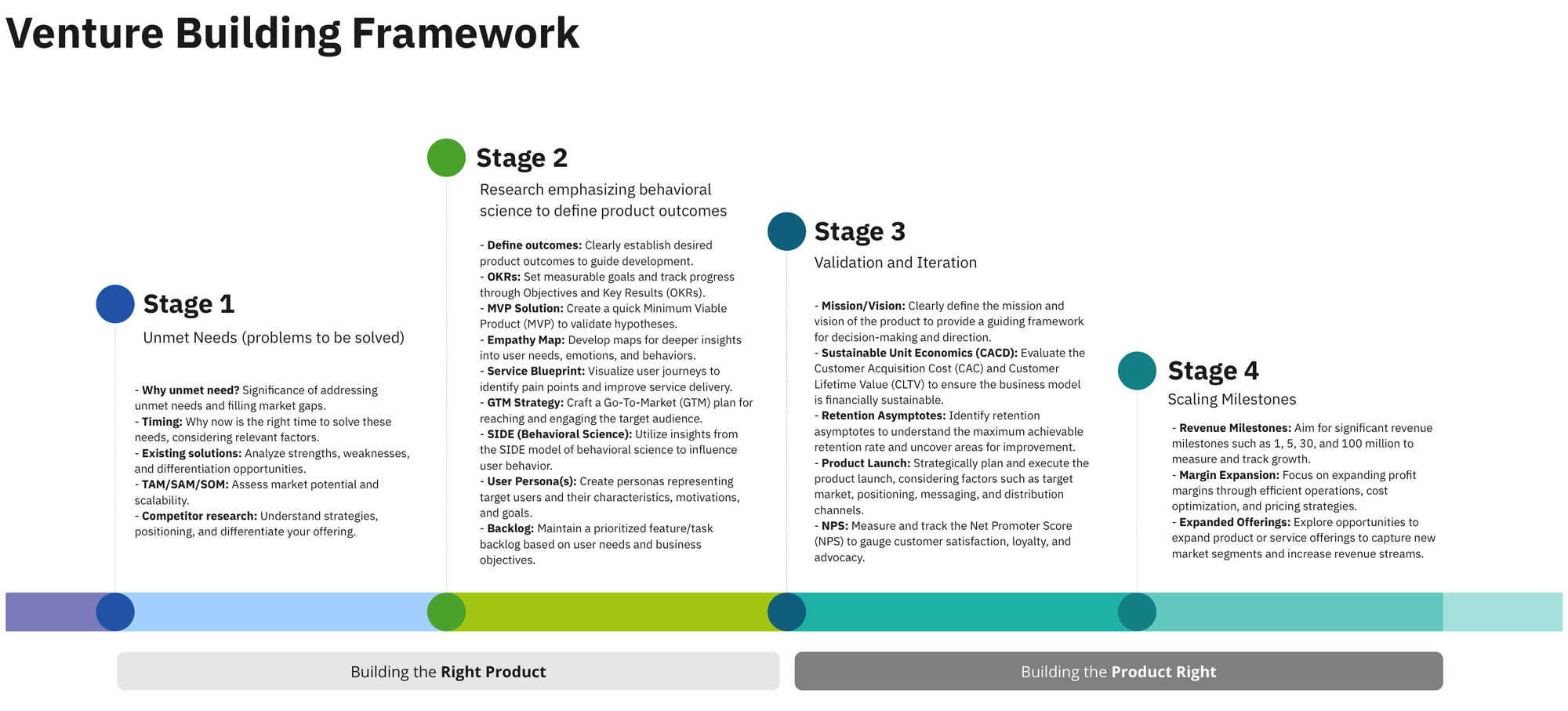

As a fellow entrepreneur who has embarked on the thrilling journey of building and scaling a startup, I wanted to take a moment to share some insights and strategies that have proven invaluable in my own ventures. Today, I would like to emphasize the significance of "venture design" and how it can help you envision the big picture while nurturing an exceptional user experience.
In an era where competition is fierce and customer expectations continue to soar, it is essential to approach your startup with a user-centric mindset. By placing the user experience at the core of your business, you not only build loyalty and trust but also set the stage for sustainable growth and success.
Now, you may wonder how to go about achieving this lofty goal. This is where the concept of venture design steps in—a holistic approach that incorporates various aspects of your business to create a seamless user experience. And when it comes to capturing the essence of venture design and its intricate details, there is no better artifact than a Service Blueprint—in my experience.
A Service Blueprint serves as a comprehensive visual representation of your business's inner workings, outlining the various touchpoints and interactions between your users and the different components of your offering. It provides a clear and concise overview of the user journey, allowing you to identify pain points, opportunities for improvement, and areas where you can truly excel.
What makes the Service Blueprint particularly powerful is its ability to encompass the entire ecosystem of your business, transcending the boundaries of individual features or functionalities. By mapping out not only the front-end user experience but also the back-end operations, customer support, and other relevant aspects, you gain a holistic understanding of your startup's dynamics.
Imagine the Service Blueprint as a panoramic lens that reveals a vivid tapestry of your startup's inner workings. It captures the intricacies of how your product or service interacts with the users, the roles and responsibilities of various stakeholders, the flow of information, and the touchpoints where your startup truly shines. This artifact empowers you to spot bottlenecks, devise innovative solutions, and create a memorable user experience that sets your startup apart.
Key Elements of a Service Blueprint: Illuminating the Inner Workings
When it comes to crafting a Service Blueprint, there are several key elements that bring clarity and insight to the intricate workings of your business. While the visual form may vary, the essence remains the same, providing a comprehensive understanding of your service. Let's explore these key elements that make up a Service Blueprint:
- Customer Actions:
These encompass the steps, choices, activities, and interactions that customers engage in while interacting with your service to achieve their desired goals. Derived from thorough research or a customer-journey map, customer actions form the foundation of your blueprint. For instance, in the context of an appliance retailer, customer actions could include visiting the website, exploring the store for appliances, consulting with a sales assistant, making a purchase, receiving delivery notifications, and finally, receiving the appliance itself. - Frontstage Actions:
Frontstage actions encompass the activities that occur directly within the customer's view. These actions can be either human-to-human interactions or human-to-computer engagements. Human-to-human actions involve the steps performed by the contact employee who directly interacts with the customer. On the other hand, human-to-computer actions occur when customers interact with self-service technology like mobile apps or ATMs.
It's worth noting that not every customer touchpoint requires a parallel frontstage action. Some interactions occur directly between the customer and the service without involving a frontstage actor.
- Backstage Actions:
Backstage actions refer to the steps and activities that happen behind the scenes to support the frontstage happenings. These actions can be performed by backstage employees, such as cooks in a kitchen, or by frontstage employees who handle tasks invisible to the customer, like entering orders into a system. Backstage actions might include warehouse employees managing inventory, shipping employees inspecting units, chat assistants coordinating with the factory, website maintenance, and marketing activities. - Processes:
Processes encompass the internal steps and interactions that support employees in delivering the service. This element comprises the necessary actions and operations that must occur to facilitate the aforementioned elements. Processes could involve credit-card verification, pricing mechanisms, unit delivery from the factory to the store, quality testing, and more.
To provide a clear and organized representation, a Service Blueprint typically organizes these key elements into clusters, with lines separating them. These lines include:
- The line of interaction: This line illustrates the direct interactions between the customer and your organization, showcasing the touchpoints and engagement throughout the customer journey.
- The line of visibility: This line divides the service activities that are visible to the customer from those that are not. Anything frontstage, which is visible, appears above this line, while backstage elements reside below it.
- The line of internal interaction: This line separates contact employees, who directly engage with customers or users, from those who provide support and contribute to the service indirectly.

Lastly, there's the layer of evidence, which encompasses the props and places involved in the blueprint. Evidence can be part of both frontstage and backstage processes and actions, adding tangible elements to the overall service experience.
Secondary Elements to Enhance Your Service Blueprint: Unleashing the Full Potential
While the core elements of a Service Blueprint lay the foundation for a comprehensive understanding of your service, there are additional elements that can further enrich its context and align with your business goals. By incorporating these secondary elements, you can adapt the blueprint to suit your specific needs.
- Arrows:
Arrows play a crucial role in service blueprinting, as they denote relationships and dependencies. A single arrow indicates a linear, one-way exchange, while a double arrow signifies the need for agreement and codependency between different components of your service. Including arrows in your blueprint visually communicates the flow and interconnections within your service ecosystem. - Time:
If time is a critical variable in your service, it's essential to represent the estimated duration for each customer action within your blueprint. By including time, you gain insights into the efficiency and duration of different stages in your service delivery, enabling you to identify bottlenecks and optimize processes accordingly. - Regulations or Policy:
Incorporating any relevant policies or regulations that dictate how a process is completed can provide valuable context within your blueprint. This information helps you understand the constraints and boundaries within which your service operates, allowing you to pinpoint areas that cannot be altered and focus your optimization efforts where they can make a meaningful impact. - Emotion:
Just as a customer's emotions are captured in a customer-journey map, it can be insightful to represent the emotions of employees in your service blueprint. This can be achieved through visual cues such as green and red faces, indicating where employees experience frustration or find motivation and happiness. If you have qualitative data on points of frustration obtained from internal surveys or other sources, incorporating them in the blueprint can help guide the design process and shed light on potential pain points. - Metrics:
Including relevant success metrics within your blueprint can provide valuable context and facilitate buy-in from stakeholders. Metrics such as time spent on various processes or the financial costs associated with them can help identify inefficiencies stemming from miscommunication or other factors. These numbers serve as tangible evidence, highlighting areas where time or money is being wasted, and driving the need for optimization.
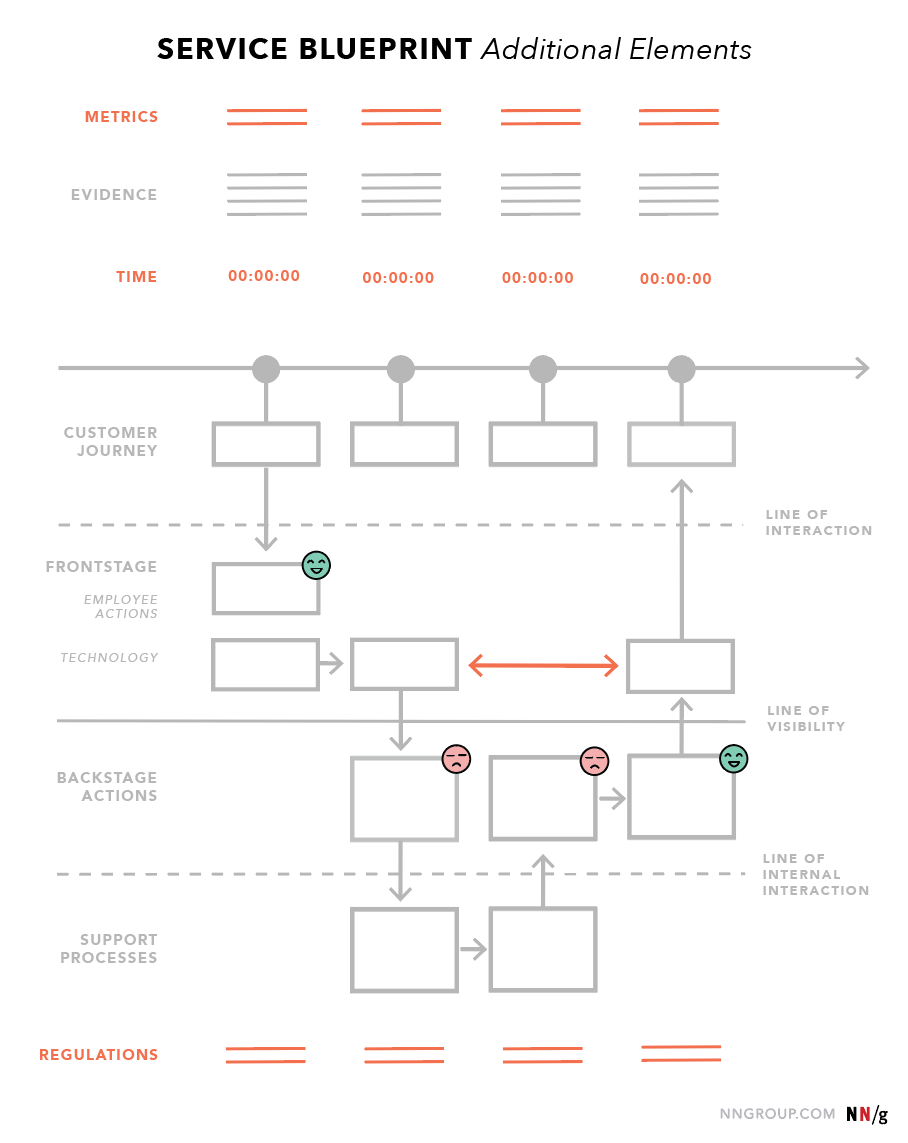

By considering and incorporating these secondary elements, you elevate the power and scope of your Service Blueprint. It allows you to capture a more nuanced understanding of your service dynamics and empowers you to make data-driven decisions to enhance the overall user experience.
Unlocking the Benefits of Service Blueprinting: Unveiling Hidden Insights
The process of constructing a service blueprint itself brings forth numerous advantages. It fosters the development of a shared vision of the service process, illuminates complexities that may have previously gone unnoticed, and provides a deeper understanding of the roles and responsibilities of task owners involved.
Building a service blueprint requires the collaboration of a cross-functional team comprising members from marketing, operations, engineering, design, HR, and occasionally even customers. This diverse group ensures comprehensive insights from different perspectives, enabling a more holistic blueprint.
To simplify the creation of your service blueprint, consider utilizing an online diagramming tool like Miro. It empowers you and your team to work collaboratively on the same canvas in real-time, offering infinite space for ideation and refinement.
Step-by-step process of creating a service blueprint:
Step 1: Identify the Service Process
Begin by identifying the specific service process that you intend to blueprint. Whether it's a main process or a sub-process, clarity on the process is vital. Establish the underlying purpose for creating the service blueprint and then determine which process to start with. It is recommended to focus on blueprinting one process at a time to maintain clarity and efficiency.
Step 2: Identify the Customer Segment
Recognize that different customer segments may have distinct needs and requirements, leading to potential variations in your service processes. If your service process differs across the various customer segments you cater to, it is crucial to blueprint these processes separately.
Dedicate this step to pinpointing the specific customer segment that aligns with the identified service process. Once determined, gain insights into the interactions of customers at each step of the process.
To gain a comprehensive understanding of customer interactions, you can refer to a customer journey map. Although the service blueprint primarily focuses on employee actions, a simplified customer journey map highlighting touchpoints and parallel actions will suffice. Thoroughly researching and understanding the customer's perspective is essential for effective blueprinting. If you have existing customer profiles for different segments, leverage them in this step. If not, consider creating customer profiles to aid in future blueprinting endeavors.
By embracing the customer's viewpoint, you can identify and eliminate process steps that have no significant impact on the customer experience.
Step 3: Map Onstage/Backstage Contact Employee Actions
Now, let's dive into mapping the service process from the perspective of both the contact employees, whether they operate frontstage or backstage. Engage with your operations employees to gather essential information on the activities they perform, both in full view of the customer and behind the scenes.
If technology plays a role in delivering the service, it's crucial to include the actions performed on the technology interface as well. Encourage your team members to contribute their insights and expertise.
Step 4: Link Contact Activities to Support Functions
In this step, you'll map the support processes that contact employees rely on to carry out the activities identified above the line of interaction. These processes may involve employees from various departments within the organization, including those who don't directly interact with customers.
Once the support functions are identified, establish the connections between the contact activities and the corresponding support functions. This step provides a deeper understanding of the direct and indirect impact of internal actions on the customer experience.
Step 5: Add Physical Evidence of Service
To complete your service blueprint, incorporate the physical evidence that customers encounter at each step of their journey. This includes any tangible or visible elements that serve as evidence of the service being provided.
Step 6: Fine-tune and Share
In the final step of creating your service blueprint, take the opportunity to refine your diagram further. Consider adding time indicators, metrics, or even employee emotions to enhance the depth of insights.
Once you are satisfied with your blueprint, it's time to share it across your organization.
Service blueprint template
When it comes to crafting a service blueprint, utilizing templates can significantly simplify the process and eliminate the need for professional design assistance. Luckily, there are a variety of templates available in different tools to suit your preferences.
- NNGroup: If you're seeking a straightforward template that can be easily used in Excel or Numbers, NNGroup offers a simple yet effective service blueprint template. It provides a user-friendly format that enables you to seamlessly capture the essence of your blueprint. Link
- Figma: For those familiar with Figma, you'll be delighted to know that there is a dedicated template available for creating service blueprints. Figma's template empowers you to leverage its powerful design capabilities while crafting a comprehensive blueprint for your service. Link
- Whiteboards: For a great and clean design, consider exploring the template available for whiteboards. This template offers a visually appealing layout that maintains simplicity while capturing the essence of your service blueprint. Embrace the blank canvas and unleash your creativity with this versatile option. Link
- Mural: If you're in search of a template that caters to all your needs, Mural has you covered. With its colorful and easily understandable design, this template serves as a visual playground, helping you craft engaging and comprehensive service blueprints. Embrace the vibrant palette and let your ideas come to life. Link
- Lucidchart: Experience the power of a clean, modern, and tasteful template with Lucidchart. This option provides a refined layout that exudes professionalism and elegance. By utilizing this template, you can create service blueprints that not only communicate effectively but also make a lasting impression. Link
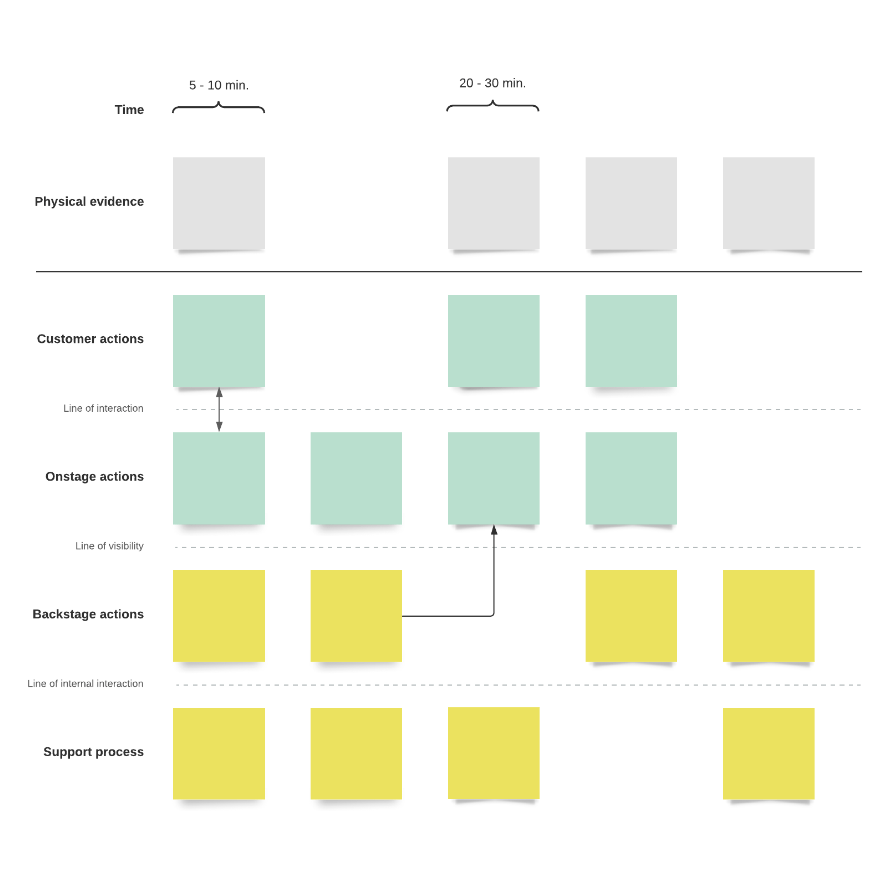
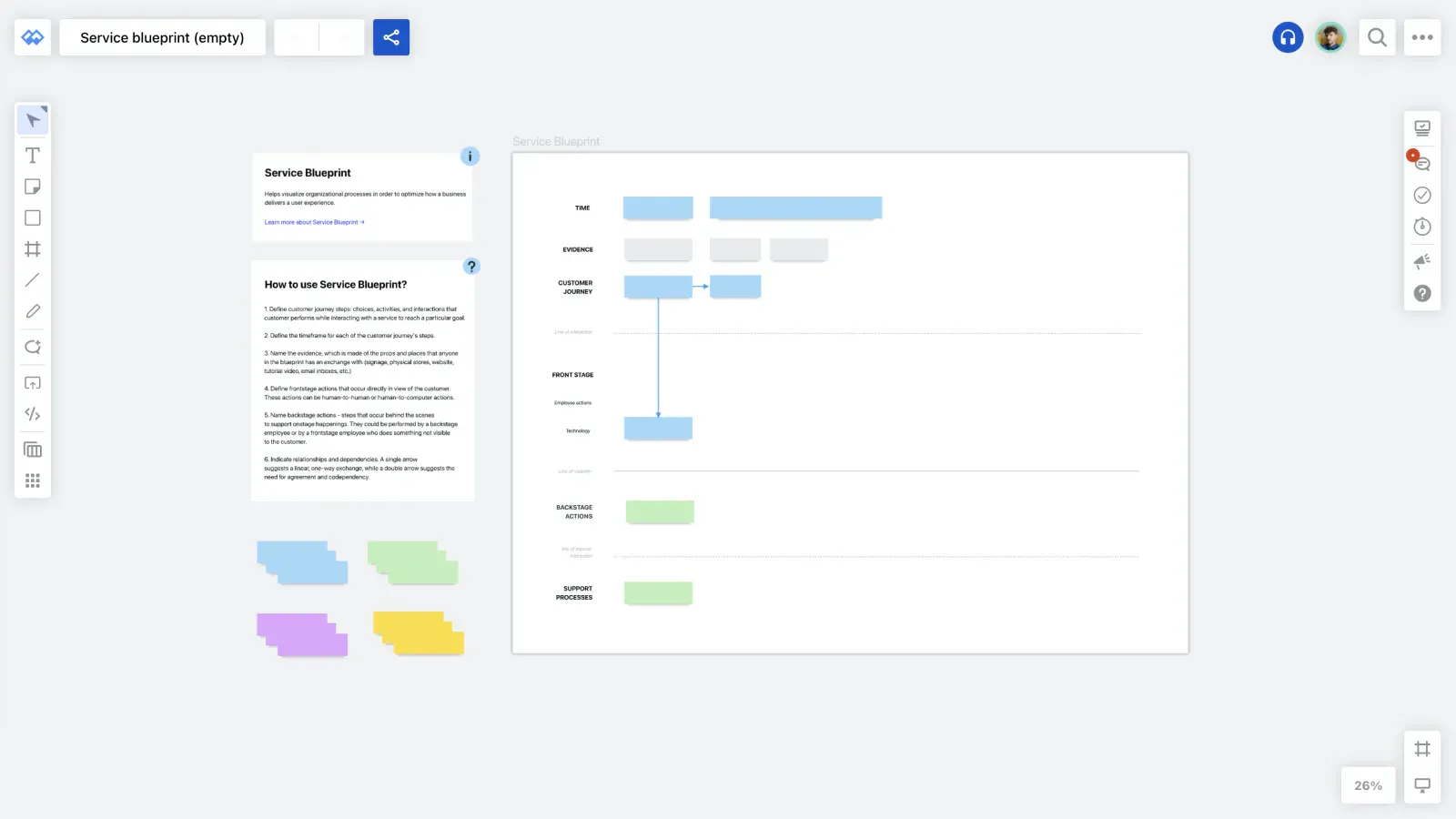

As you embark on your entrepreneurial journey, I encourage you to embrace the power of venture design and invest the time and effort to create a compelling Service Blueprint. Remember, your startup's success hinges not only on the brilliance of your idea but also on the seamlessness of the user experience you deliver.
Examples:
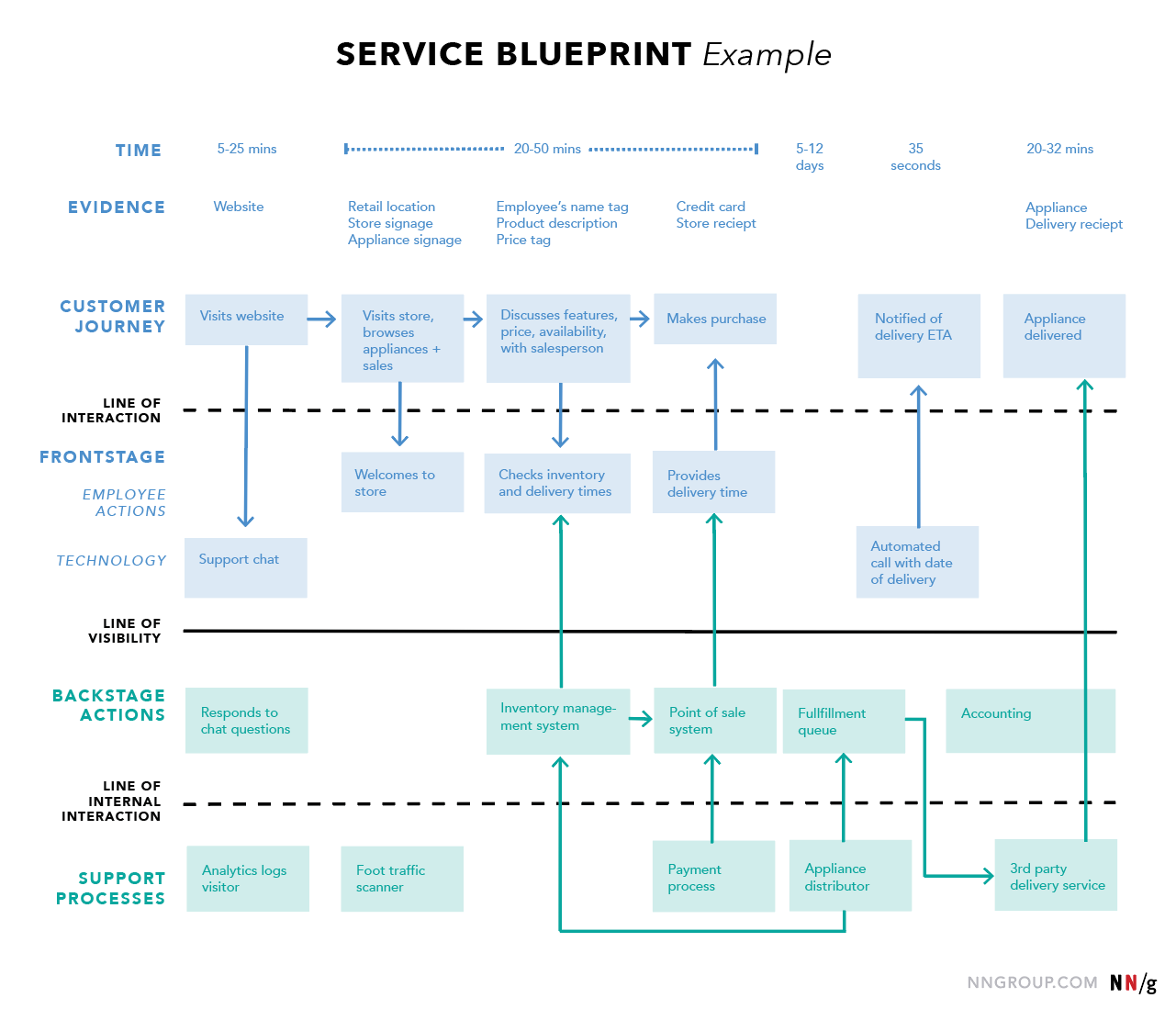
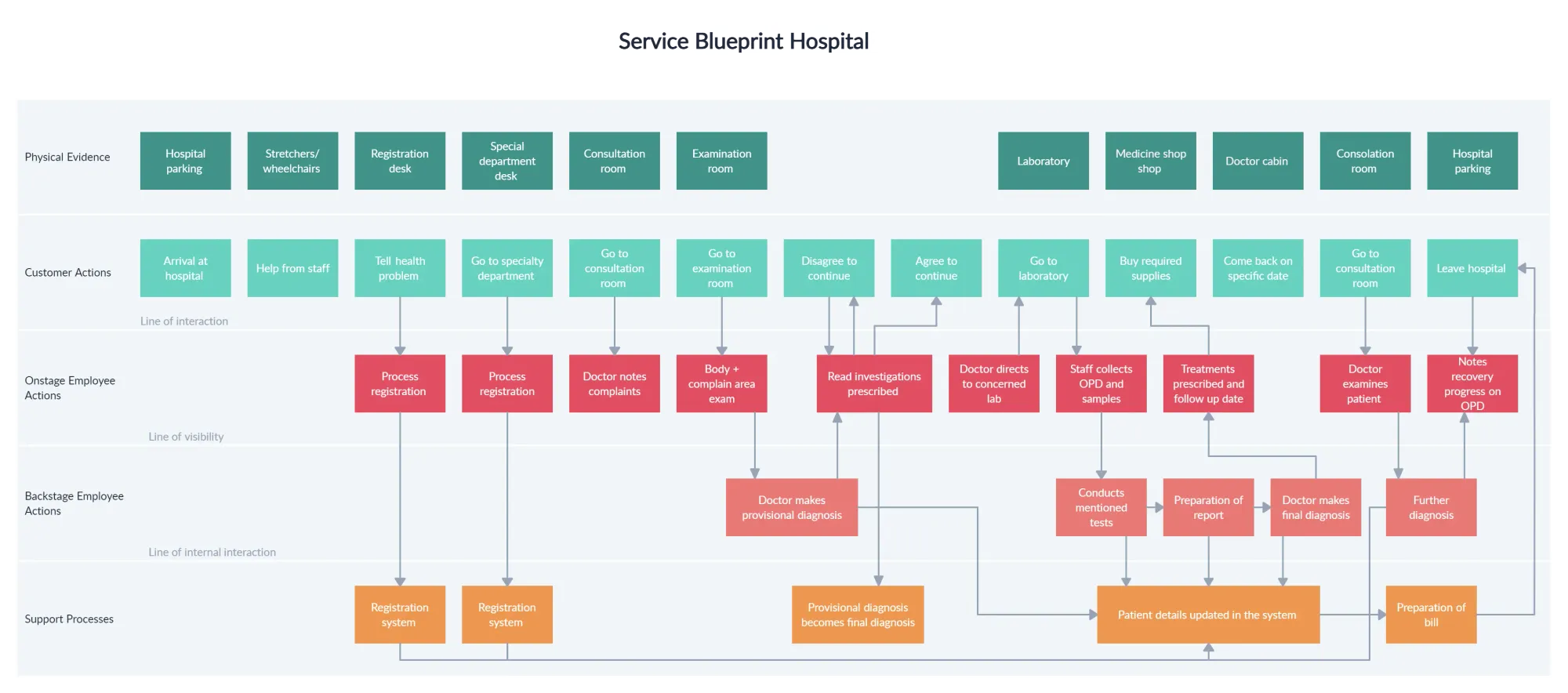
This artifact is part of Stage 2 of the Venture Buildinag Framework.
This is a powerful output as you work to ensure you are Building the Right Product.
